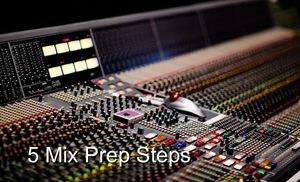- in Book Excerpt , Engineering by Bobby Owsinski
Improve Your Mix Workflow With These 5 Prep Steps
 These days a typical session has plenty of tracks that won’t be used in the final mix. Deleting or hiding these tracks and then putting the rest in a logical order can be the single most useful thing you can do while prepping your mix. In this excerpt from the 4th edition of my Mixing Engineer’s Handbook, you’ll find a number of steps to take to improve your workflow if you’ll be mixing the song yourself, or especially, if you’ll be giving it to someone else to mix.
These days a typical session has plenty of tracks that won’t be used in the final mix. Deleting or hiding these tracks and then putting the rest in a logical order can be the single most useful thing you can do while prepping your mix. In this excerpt from the 4th edition of my Mixing Engineer’s Handbook, you’ll find a number of steps to take to improve your workflow if you’ll be mixing the song yourself, or especially, if you’ll be giving it to someone else to mix.
1. Delete Empty Tracks
Empty tracks take up space in your edit and mix windows without adding anything useful, so it’s best to delete them. During tracking or overdubs, it frequently makes sense to have empty tracks readily available so you can go instantly to another take or overdub with a minimum of time, but if you’ve gotten to the mix stage without using some of them, they’re only taking up space on your desktop, making it more difficult to see some of the channels you really need. Delete them.
2. Deactivate and Hide Unused Tracks
Any tracks that you know won’t be needed (sometimes they’re marked or color-coded beforehand) just soak up your computer’s system resources. Even with a power machine, these resources may become a precious commodity if you end up using a lot of plugins during the mix. Deactivate the tracks and then hide them from the timeline and mix panels so they don’t distract you and take up desktop space.
3. Reorder Your Tracks
Reordering tracks into logical groups of instruments or vocals makes finding individual instruments or vocals easier during the mix. The idea is to group any similar instruments or vocals together, so all the guitars are next to each other, the drums and percussion are next to one another, and keyboards, horns, strings, and all the vocals are together. This makes it easier not only to find a track, but also to group them later if needed.
4. Color-Code the Tracks
This isn’t absolutely necessary, but it does make things easier to find if your DAW app has this ability. For instance, all the drums might be red, guitars blue, the vocals yellow, and so on.
5. Correctly Label the Tracks
Many workstation apps automatically assign a name to any new track that has been recorded, but usually the names don’t relate to the instrument (see Figure 3.4). It’s really easy to mistake one track for another and turn a fader or parameter knob up and up and wonder why nothing is happening, only to find that you’re tweaking the wrong track. That’s why it’s important to clearly label each track that has a name like “gt166†to something descriptive like “guitar†or “ rhythm gtr.†Consider this to be the same as identifying the channels of a console with console tape, and make it a habit when prepping.
Even if it’s your own project, don’t assume that you’ll be the only one to ever mix it. Label each track so that anyone can easily identify it. Labels such as “John 1†and “Paul 4†don’t mean anything to anyone but you. Who’s John? What is Paul playing or singing? Mark each track logically.
You can read more from The Mixing Engineer’s Handbook and my other books on the excerpt section of bobbyowsinski.com.
